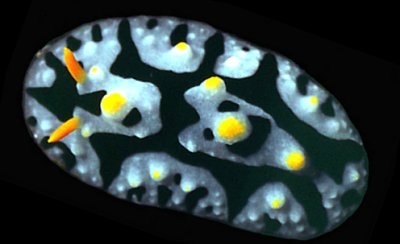
Phyllidia schupporum
Fahrner & Schrödl, 2000
Order: NUDIBRANCHIA
Suborder: DORIDINA
Superfamily: EUDORIDOIDEA
Family: Phyllidiidae
DISTRIBUTION
Currently known from the Gulf of Aqaba, Northern Red Sea (Egypt) only.
PHOTO
Living holotype, 30 mm long; found on 'INMO-Reef', Dahab, Gulf of Aqaba, Red Sea,
at 12 m depth, 27. Oct. 1998.
This species is characterized by a white background colour and two broad, median, longitudinal, black lines on the dorsum from which short, black stripes extend to the mantle margin. The longitudinal lines are connected by a transverse line medially, resulting in two central white areas. Three or four large, white semicircles occur around each side of the mantle margin. Several irregularly shaped black spots are spread over all the white areas. There is no distinctly coloured edge to the mantle margin. Isolated and rounded, white tubercles with yellow tips cover the notum. The rhinophores are orange-yellow, each clavus possesses 14 lamellae. Ventrally, foot and notum are white, despite of the black markings of the dorsum that are visible on the hyponotum and the dark grey edge of the foot. The gills are grey and the separate, conical oral tentacles are white with orange tips.
NOTE: See Bernard Picton's message suggesting this is really a synonym of P. multifaria.
References:
• Fahrner, A. & Schrödl, M. (2000) Description of Phyllidia schupporum, a new nudibranch species from the northern Red Sea (Gastropoda, Nudibranchia, Phyllidiidae). Spixiana, 23(1): 55-60.
• Fahrner, A. & Schrödl, M. (2000). Redescription of Phyllidiopsis sinaiensis (Yonow, 1988) (Nudibranchia: Doridoidea: Phyllidiidae), with a review of the Red Sea Phyllidiidae. Journal of Molluscan Studies, 66(4): 467-476.
Fahrner, A. & Schrödl, M, 2000 (August 13) Phyllidia schupporum Fahrner & Schrödl, 2000 . [In] Sea Slug Forum. Australian Museum, Sydney. Available from http://www.seaslugforum.net/factsheet/phylschu
Related messages
-
Re: Phyllidia schupporum from the Red Sea
From: Binyamin Koretz, June 28, 2007 -
Phyllidia schupporum & Phyllidiella hageni
From: Alexander Fahrner, August 16, 2000
